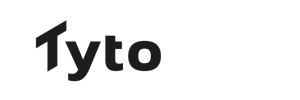Champions of Content – Q&A with Doug Drinkwater: Director of Strategy at HotTopics
Welcome to the latest entry in our series: Champions of Content
Content is integral to the way brands are understood and seen by their audiences, but developing content for different audiences, on different channels and even in different languages can be very complicated to get right.
In Champions of Content, we’ll be speaking to passionate content creators we admire including marketers, journalists, writers, podcasters, and speakers about their experiences and sharing the wisdom to help others on their own content journey – whether your first putting pen to paper or looking to level up your content strategy.
Doug Drinkwater is a business technology journalist, editor, publisher and content strategist with over a decade’s experience in media. He has worked for several leading B2B and B2C technology publications and reported on the biggest companies in the world, from Apple and Google to Meta and Microsoft.
His previous roles have included editor of CIO UK, senior director of content at IDG, and launch editor and head of publishing at technology publication Internet of Business. He is currently director of strategy at HotTopics, the C-suite community.
In this conversation, Doug talks about his background, what role generative AI will play in the future of content creation, and the importance of choosing the right metrics to measure the success of your campaigns.
Please can you start by telling us about your own career journey as it relates to content and what role content plays in your work today?
I’ve always loved writing, ever since school. As a child, I made my own weekly newspaper which I would sell to friends and family. My dad still has a few copies now, which reminds me I must burn them so they never see the light of day.
After my A-levels, I worked in retail for a short time before studying journalism at college. Initially, I wanted to be a sports journalist, and I did some work for national newspapers and football magazines, but I eventually fell into technology journalism – initially, working for a trade journal covering the display electronics industry at a time where CRTVs where still a thing, and a 10” OLED TV would cost you tens of thousands of pounds.
From there, I’ve had different roles at a variety of publications, moving from reporter to section editor, to editor, publisher, and content director, although I’ve never lost that love for writing and learning, which you get from being a reporter.
Over the course of my career, I’ve reported on some pivotal moments in the tech world, from the launch of Apple’s iPad and Windows 8/10, to Edward Snowden’s revelations about government surveillance and Microsoft’s early investment in OpenAI. There’s been some duds and slower burners along the way too – such as excitement over 3DTVs in the early 2010s and the early hype over Blockchain, the Internet of Things and virtual reality.
In my new role, it’s the first time that content is no longer the only thing I am focused on. As director of strategy, it’s my job to work with our team to decide what we as an organisation will do going forward.
HotTopics is a successful events company, which has run big events at Tottenham Hotspur Stadium and Abbey Road Studios for technology, business and marketing decision-makers, but we know that the B2B events industry has mushroomed since the pandemic.
My role is to help create a pathway for where the organisation wants to go. It’s about making HotTopics become more of a place for people to come to, rather than simply an event you attend twice a year.
Content and editorial are a big part of our plans, but it’s also about building a great community of technology and business leaders, adding value by sharing knowledge, creating connections, and giving back through TechGirl and other initiatives.
Whose content – brands or individuals – do you admire most and why?
As a journalist, The Guardian, the Financial Times and the BBC have always stood out for their editorial integrity, independence, and authority. In technology specifically, I’ve always enjoyed reading Wired, Quartz – and in B2B specifically – the likes of ComputerWeekly, Digninomica and The Stack.
In terms of content marketing, some technology and cybersecurity brands have excelled in this space for some time, having recognised that content can be a way of sharing expertise and building trust with their audience, their prospective buyers.
One example that stands out is software company Red Hat. About a decade ago, they established The Enterprisers Project, which became like an independent environment for IT and security leaders to learn and educate themselves, without ever having a big sales push.
Adobe has also done a great job of producing compelling content that is relevant and interesting to their audience but also stays true to who they are as a brand.
We all want our content to stand out, what do you think are the main ingredients that make one piece of content stand out above another?
It often comes back to the basics: who’s your target audience? What are their pain points or problems? And how does that align to your messaging? That’s relevant, no matter if you’re working with earned, owned, or paid media.
Saying that, you do also need a degree of flexibility. Some of the companies I’ve worked with over the past have been so rigid about their messaging and brand guidelines that they almost lose any sense of personality, and that includes how their own experts come across in interviews.
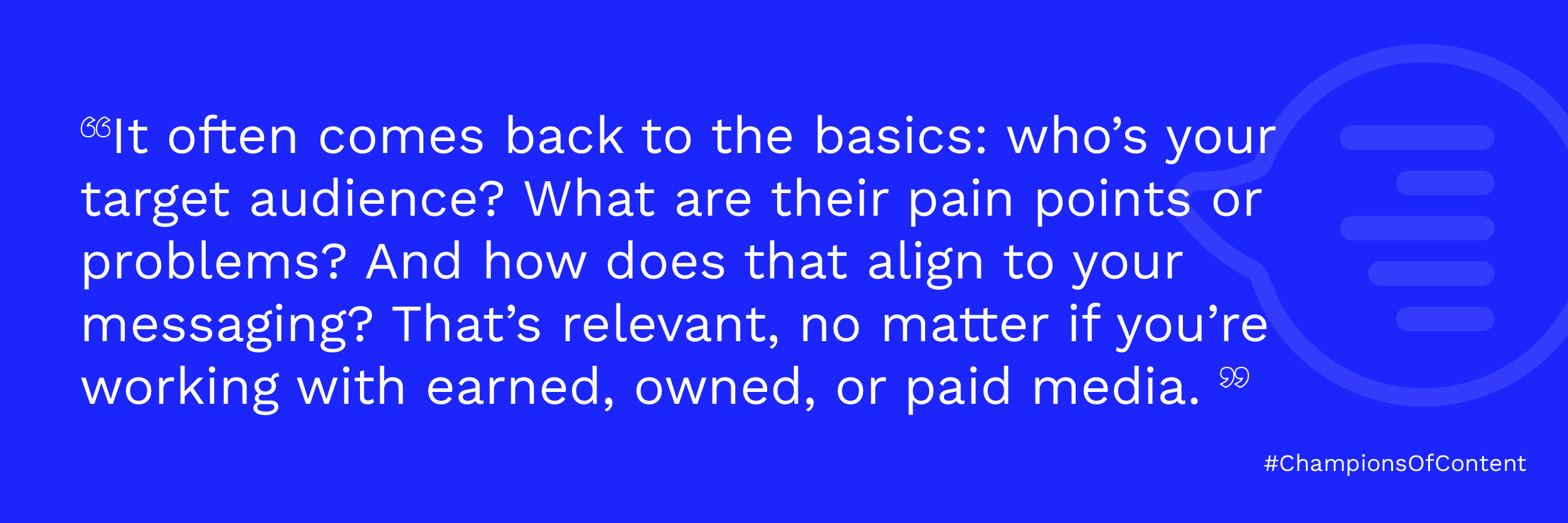
Personality is important, because people buy from people, and are more likely to buy from brands that are educational, trustworthy and have a purpose.
Also, it sounds obvious, but you need to be sharing knowledge and insights. Business leaders don’t always respond well to sales pitches, but they do like to learn. Research has continually shown that people buy from brands who educate them during the sales journey, so make sure your content is thought-provoking and adds value – if it doesn’t, it’s a waste of everyone’s time, including yours.
Time is also critical, because results don’t happen overnight. This applies whether you’re a publisher looking to build a community and following, or a marketer trying to get ROI through content marketing. Notwithstanding the current cost pressures, I’ve seen with tech marketers in the past pivot to something else entirely, having spent the previous year building a growing online community with good audience engagement. If you have a goal, stick to it, measure and adapt accordingly based on the results.
Finally, you’ve got to be authentic. If you are transparent, you can build trust with your audience, especially if you’re facing similar problems. Try sharing some of your own challenges and experiences, and what you’re doing about them. Business and technology leaders are more interested in this than you might think.
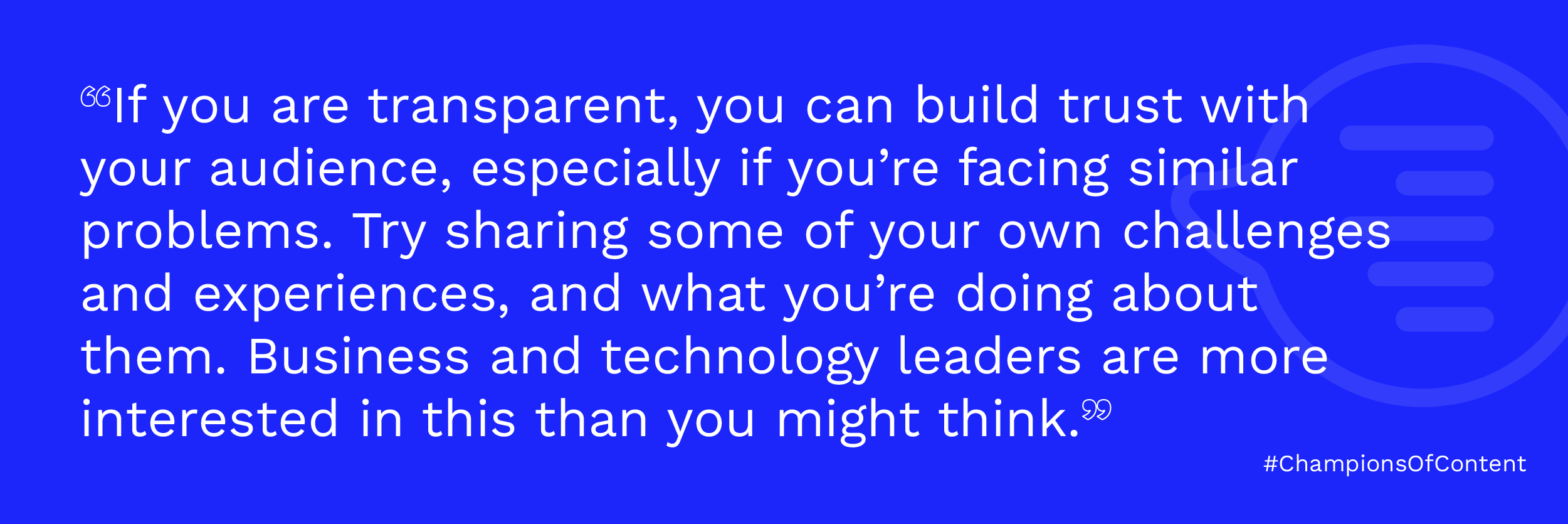
What are some of the challenges you face when producing content for different channels and audiences, and how do you deal with these? Here at Tyto, we often navigate the complexity of developing content for different audiences in different countries.
I’ve worked in B2B technology for the best part of 15 years, and what you realise is that the issues CIOs, CTOs and CISOs are dealing with are cyclical. They come back again and again. So the challenge to make content for that audience is making it different and original. What can you say that no one has said before? What does your story offer that people can’t already access elsewhere?
That applies to PRs, journalists and vendors. Companies in the tech industry are often all fighting for the same audience and talking about the same topics.
There’s a massive issue around content saturation, because with so much content available, people don’t have the time to consume huge amounts of material, and not everyone consumes in the same way. I’ve just checked – I’ve got 70 tabs open at the moment, including articles from a handful of publishers I keep meaning to read. According to Hubspot, the average time spent on page across all industries is 54 seconds.
You also need to be flexible. Some of the best content marketing campaigns I’ve worked on are the ones that had a bit more flexibility around their messaging, because you’ve got to be able to respond to what’s happening in the market and the economy. But make sure it is something you are qualified to speak on, otherwise you’ll lose authenticity. Also, look internally to your own experts. They can tell you what the problems and solutions are that your audience care about.
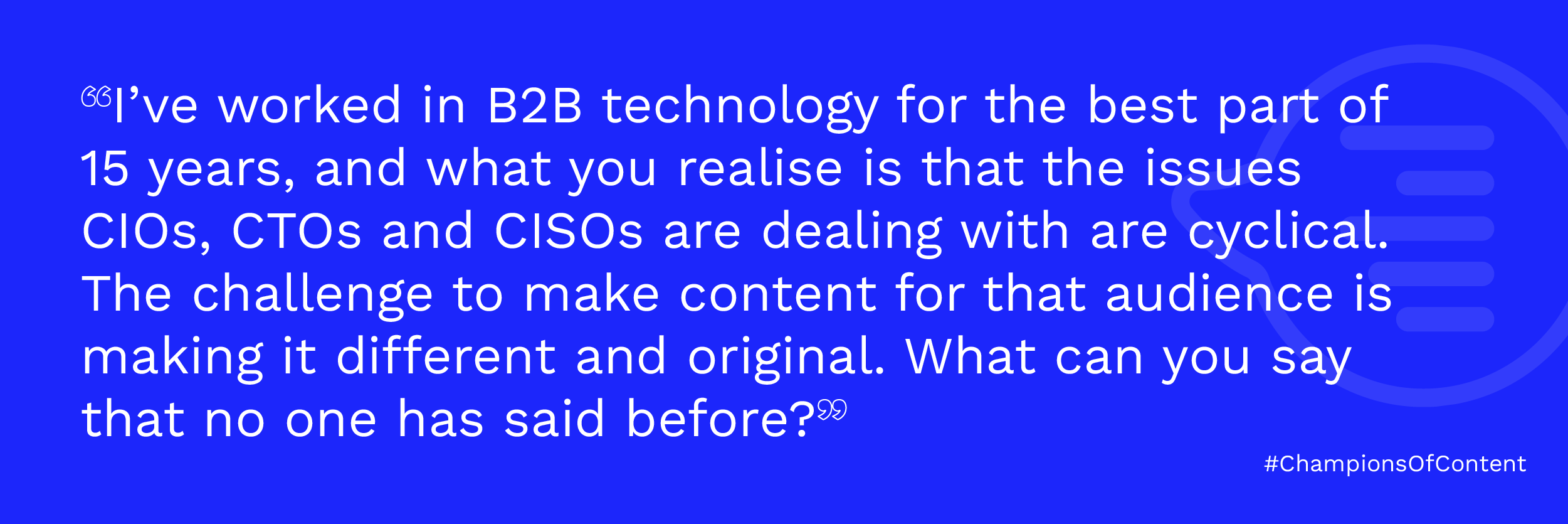
Are you excited by AI and ChatGPT, and if so, where do you see the greatest potential to harness it in the development of content, now or in the future?
This technology has massive potential to revolutionise the media and content industry, similar to how social media and the web has done in the past.
But it’s still very early days – the technology is a long way from maturity and some of the large language models are simply regurgitating a lot of stuff. When it comes to content, I think people are generally wowed by some quite basic results and that concerns me in a media industry that has already hugely disrupted by Google and Facebook and which is currently seeing a record number of job cuts.

That said, anyone in PR or content creation needs to think about how they will use these tools. Those who can make the best use of these tools will have a leg up on the competition. I think ChatGPT can be of enormous value in helping you to build your messaging and defining your value proposition, and it can do tasks quickly, potentially saving you hours of work.
But anything ChatGPT produces still needs human oversight and analysis to check for any errors. This technology should not be dismissed, but we should treat it with a degree of scepticism. I am feeling confident long-term that human creativity and ingenuity will trump what a machine can produce.
For brands or individuals planning to level up their content in 2023, what would be your top three bits of advice for how they can increase the impact of their content? What should they be thinking about and looking at? What are you thinking about?
First, set clear goals and metrics. There are so many metrics in the world to analyse, from session times to page views to bounce rates and exit rates, that it can be hard to see what success looks like. A marketing director could wake up one day, look at their dashboard and think they’re doing fantastically well. The next day they might look at a different metric and think it’s the worst campaign they’ve ever worked on.
That’s why you need to define really early on what you want to achieve, what success looks like, and which metrics are most appropriate for you to track. For example, if you are looking to drive awareness, you might track page views over time or dwell time. If your focus is lower down the sales funnel, then tracking downloads or engagement with sales brochures might be the target metric. Of course, these parameters may change over time as business objectives evolve. It may be something more intangible – at our Studio at Abbey Road Studios last month, Rory Sutherland, said we don’t have a metric for qualitative things, like emotion.
Second, give it time. If your objective is to build your brand as a trustworthy source of authority, then you need to give your team the necessary time, tools and resources to do that. If you expect instant results, you’re going to be disappointed. So set a goal, stick to a plan and schedule check-ins along the way to see how you’re tracking.
Third, focus on building a community using your content. If you discuss problems and solutions, people will come back time and time again to learn and educate themselves. That will build greater trust and affiliation with your brand.
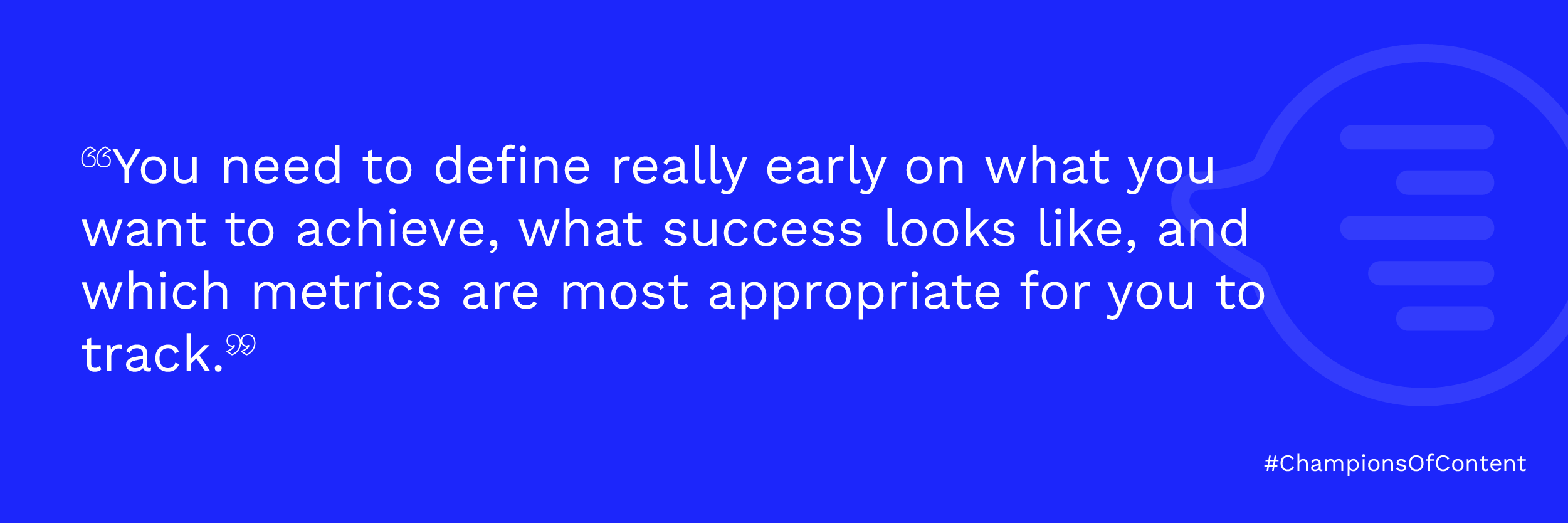
Final question, how do you measure the success of your content?
Again, it depends on what your objective is, as that will determine which metrics to track. If you’re trying to build awareness or engagement, then page views, dwell time and social media comments are important. Further down the sales funnel, the focus might be around leads or follow-up calls.
There are plenty of BI tools and account-based management software that can help bring this information together and help you see how people are engaging with your content. There are so many potential metrics to track, that it’s important you bring it down to just a few targets.
